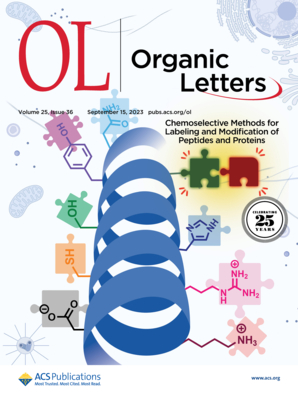用分子内电荷转移配合物对C(sp2)-H的二氟烷基化进行可见光诱导的碘化磷盐直接光解。
IF 5
1区 化学
Q1 CHEMISTRY, ORGANIC
引用次数: 0
摘要
绿色、安全、简单和高效的生产氟烷基的策略是合成界面临的一个持续挑战。一般来说,合成二氟烷基化杂芳烃化合物的主要形式是利用催化剂、氧化剂和高温生成二氟烷基自由基,与杂芳烃反应。相比之下,利用分子内电荷转移配合物(ictc)生成二氟烷基化杂芳烃化合物的策略仍然是一个未探索的挑战。本文首次以光活化ictc形式生成的多种二氟烷基自由基与稳定性高、活性位点多的杂芳香C(sp2)-H化合物进行了二氟甲基化反应,得到了多种含氟化合物。这种方法只依赖于反应中的底物,避免了对金属、外源光催化剂和氧化剂的需要。此外,这种无金属的方法提供了可控的合成条件,采用了具有高时空效率的可扩展流动技术,并成功地在克尺度上应用,从而证明了这种新方案的实用性和通用性。本文章由计算机程序翻译,如有差异,请以英文原文为准。
Visible-Light-Induced Direct Photolysis of Phosphorus Iodide Salts for Difluoroalkylation of C(sp2)-H by an Intramolecular Charge-Transfer Complex.
Green, safe, simple, and efficient strategies for generating fluoroalkyls are an ongoing challenge for the synthetic community. Generally, the main form of synthesizing difluoroalkylated heteroaromatic compounds is to use catalysts, oxidants, and a high temperature to generate difluoroalkyl radicals and react with heteroaromatic hydrocarbons. In contrast, the strategy of using intramolecular charge-transfer complexes (ICTCs) to generate difluoroalkylated heteroaromatic compounds remains an unexplored challenge. Here, for the first time, we carried out a difluoromethylation reaction between various difluoroalkyl radicals generated in the form of photoactivated ICTCs and heteroaromatic C(sp2)-H compounds (with high stability and multiple active sites) to obtain various fluorine-containing compounds. This method only depends on the substrate in the reaction, avoiding the need for a metal, exogenous photocatalyst, and oxidant. In addition, this metal-free approach provides controlled synthetic conditions, employs a scalable flow technique with high temporal and spatial efficiency, and demonstrates successful gram-scale applications, thus proving the usefulness and versatility of this new scheme.
求助全文
通过发布文献求助,成功后即可免费获取论文全文。
去求助
来源期刊

Organic Letters
化学-有机化学
CiteScore
9.30
自引率
11.50%
发文量
1607
审稿时长
1.5 months
期刊介绍:
Organic Letters invites original reports of fundamental research in all branches of the theory and practice of organic, physical organic, organometallic,medicinal, and bioorganic chemistry. Organic Letters provides rapid disclosure of the key elements of significant studies that are of interest to a large portion of the organic community. In selecting manuscripts for publication, the Editors place emphasis on the originality, quality and wide interest of the work. Authors should provide enough background information to place the new disclosure in context and to justify the rapid publication format. Back-to-back Letters will be considered. Full details should be reserved for an Article, which should appear in due course.
 求助内容:
求助内容: 应助结果提醒方式:
应助结果提醒方式:


